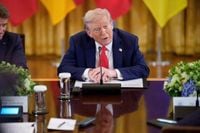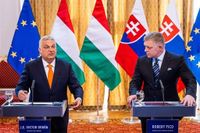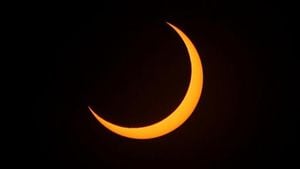US President Donald Trump has escalated his calls for NATO and European Union allies to clamp down on Russian oil imports, arguing that a united front is essential to end the ongoing war in Ukraine. Over the past week, Trump has repeatedly pressed European leaders to halt purchases of Russian crude and to impose steep tariffs on countries like China and India, which he accuses of funding Moscow’s war effort through their energy trade.
Trump’s demands, delivered through social media posts, press conferences, and diplomatic channels, reflect a growing frustration in Washington with what he sees as Europe’s reluctance to tighten the economic screws on Russia. On September 13, 2025, Trump took to his Truth Social platform to urge, “all NATO nations” to stop importing Russian oil, warning that continued purchases weaken the West’s negotiating position. “As you know, NATO’S commitment to WIN has been far less than 100%, and the purchase of Russian Oil, by some, has been shocking! It greatly weakens your negotiating position, and bargaining power, over Russia. Anyway, I am ready to ‘go’ when you are. Just say when?” he wrote, according to RFE/RL and The Independent.
Only three NATO members—Hungary, Slovakia, and Turkey—currently import significant volumes of Russian crude. Of these, Turkey stands out as the third largest Russian oil importer worldwide, trailing only China and India. “Turkey buys Russian oil mainly because it’s heavily discounted,” Petras Kanitas, an analyst at the Center for Research on Energy and Clean Air, told RFE/RL. Turkish refineries, in some cases, source up to 90 percent of their crude from Russia, making any abrupt shift away from Russian supplies a daunting prospect for Ankara.
Hungary and Slovakia, meanwhile, are heavily dependent on the Druzhba pipeline, which has been repeatedly disrupted by Ukrainian air strikes. Hungarian Foreign Minister Peter Szijarto warned in August that, “if deliveries via the Druzhba pipeline become impossible for a long time, then the oil supply to Hungary and Slovakia will also become impossible.” Yet, as RFE/RL reports, the European Union has set a goal of eliminating Russian energy imports by 2027, using internal market rules that would prevent Hungary or Slovakia from wielding a veto.
Analysts believe that both countries could theoretically switch to alternative sources, such as the Adria pipeline through Croatia, but acknowledge that doing so would raise fuel costs and require political will. “Diversification is not an insoluble technical problem but a matter of political and economic will,” Tamas Pletser, an oil and gas analyst at Erste Bank, told RFE/RL’s Hungarian Service.
For Trump, the stakes extend well beyond Europe. He has already imposed a 25 percent tariff on India for its purchases of Russian oil, a move New Delhi denounced as “unjustified and unreasonable.” India, which imported around 88 million tons of Russian oil last year—about 35 percent of its energy needs—resells much of it to other countries, mostly in Europe. Trump has called for even steeper tariffs, ranging from 50 to 100 percent, on China, which imported over 100 million tons of Russian crude in 2024, accounting for about 20 percent of its annual needs.
China, for its part, has pushed back hard. On September 15, Chinese Ministry of Foreign Affairs spokesperson Lin Jian warned that Beijing would “resolutely take countermeasures to safeguard” its sovereignty and economic interests if targeted by Western tariffs. “No amount of external pressure or coercion will make [China] compromise its ‘sovereignty, security and development interests,’” Lin said, as reported by Xinhua and Reuters. Chinese officials have repeatedly asserted that their trade with Russia follows World Trade Organization rules and market principles, and that they do not support the war in Ukraine.
Trump’s strategy has found some support among US lawmakers. Republican Senator Lindsay Graham, for example, has advocated for “massive secondary tariffs to choke Russia’s trading partners,” telling NBC’s Meet the Press, “It is now time for the Europeans to follow President Trump’s lead and go after China and India. This war will end.” However, no European leaders have publicly indicated a willingness to hike tariffs or cut oil imports from Russia as of mid-September. The EU, facing its own economic headwinds, remains cautious about provoking further retaliation from Beijing. On September 15, the Chinese Foreign Ministry warned of “firm countermeasures” if NATO countries “hit China with tariffs.”
Meanwhile, the pressure campaign has played out against the backdrop of recent escalations in the Ukraine conflict. On September 12, multiple Russian drones entered Polish airspace—a move US Secretary of State Marco Rubio called “unacceptable and unfortunate and dangerous.” While Poland shot down the drones, Rubio noted that it was unclear whether the incursion was intentional, but he emphasized that “if that’s the case, that the evidence leads us there, then obviously that would be a highly escalatory move.” At an emergency UN Security Council meeting the next day, acting US Ambassador Dorothy Shea stated, “America will defend every inch of NATO territory,” underscoring the seriousness with which Washington views such incidents.
Despite his tough rhetoric, Trump has sometimes been criticized for a perceived reluctance to directly confront Russian President Vladimir Putin. Last month, he hosted Putin in Alaska for talks that ultimately failed to achieve progress toward peace. Congress is now pushing for legislation that would toughen sanctions on Moscow, seeking to demonstrate a firmer resolve in support of Ukraine. Trump, for his part, continues to insist that “Zelensky’s gonna have to make a deal. And Europe has to stop buying oil from Russia,” as he told reporters earlier this week.
Britain has also taken steps to penalize the Russian oil trade, banning 70 vessels allegedly used for transportation and sanctioning 30 individuals and companies, including businesses based in China and Turkey, for supplying Russia with electronics, chemicals, and weapons components. The US and its allies are seeking to present a unified front, but the challenge of aligning the interests of so many diverse economies remains formidable.
In the midst of these tensions, the Group of Seven (G7) met last week to discuss new sanctions on Russia and possible tariffs on countries accused of enabling the war. US trade representative Jamieson Greer and Treasury Secretary Scott Bessent urged their counterparts to maintain a “unified front” to cut off “the revenues funding Putin’s war machine.” Yet, as of mid-September, no concrete moves have been announced by European leaders to either increase tariffs or end imports of Russian oil.
As the war in Ukraine grinds on, Trump’s demands have injected new urgency—and controversy—into the debate over how best to pressure Russia and its trading partners. Whether Europe will heed his call, or whether the economic and political costs will prove too great, remains to be seen. For now, the world watches as the standoff continues, with no easy end in sight.






